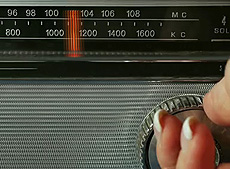Heisenberg's uncertainty principle and Wi-Fi
 |
| Bandwidth, or the spreading of a radio station onto multiple, neighboring frequencies, is related to uncertainty in quantum mechanics. |
When I first started teaching, I was stumped by a student who asked me if quantum mechanics affected anything in daily life. I said that the universe is fundamentally quantum mechanical and therefore it affects everything, but this didn't satisfy him. Since then, I've been noticing examples everywhere.
One surprising example is the effect of Heisenberg's uncertainty principle on Wi-Fi communication (wireless internet). Heisenberg's uncertainty principle is usually described as a limit on knowledge of a particle's position and speed: The better you know its position, the worse you know its speed. However, it is a general principle with many consequences. The most common in particle physics is that the shorter a particle's lifetime, the worse you know its mass. Both of these formulations are far removed from everyday life, though.
In everyday life, the wave nature of most particles is too small to see. The biggest exception is radio and light, which are wave-like in daily life and only particle-like (photons) in the quantum realm. In radio terminology, Heisenberg's uncertainty principle is called the bandwidth theorem, and it states that the rate at which information is carried over a radio band is proportional to the width of that band. Bandwidth is the reason that radio stations with nearly the same central frequency can sometimes be heard simultaneously: Each is broadcasting over a range of frequencies, and those ranges overlap. If you try to send shorter pulses of data at a higher rate, the range of frequencies broadens.
Although this theorem was developed in the context of Morse code over telegraph systems, it applies just as well to computer data over Wi-Fi networks. A typical Wi-Fi network transmits 54 million bits per second, or 18.5 nanoseconds per bit (zero or one). Through the bandwidth theorem, this implies a frequency spread of about 25 MHz, but the whole Wi-Fi radio dial is only 72 MHz across. In practice, only three bands can be distinguished, so only three different networks can fill the same airwaves at the same time. As the bit rate of Wi-Fi gets faster, the bandwidth gets broader, crowding the radio dial even more.
Mathematically, the Heisenberg uncertainty principle is just a special case of the bandwidth theorem, and we can see this relationship by comparing units. The lifetime of a particle can be measured in nanoseconds, just like the time for a computer to emit a zero or a one. A particle's mass, which is a form of energy, can be expressed as a frequency (for example, 1 GeV is a quarter of a trillion trillion Hz). Uncertainty in mass is therefore a frequency spread, which is to say, bandwidth.
Although it's fundamentally the same thing, the numerical scale is staggering. A computer network comprising decaying Z bosons could emit 75 million petabytes per second, and its bandwidth would be 600 trillion GHz wide.
—Jim Pivarski
|